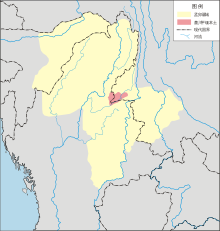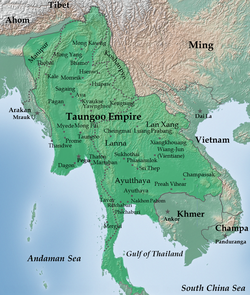Upper Assam division
Upper Assam | |
|---|---|
 Jorhat is the most developed city in Upper Assam division | |
 The five divisions of Assam | |
| Country | India |
| State | Assam |
| Largest city | Jorhat |
| Headquarters | Jorhat |
| Population | |
| • Total | 7.5 million |
| Time zone | UTC +05:30 (IST) |
Upper Assam is an administrative division of the state of Assam comprising the undivided Lakhimpur and Sivasagar (previously, Sibsagar) districts, of the upper reaches of the Brahmaputra valley. The other divisions are: Lower Assam, North Assam and Hills and Barak Valley. The division is under the jurisdiction of a Commissioner, stationed at Jorhat.
Consisting of 7 districts initially, the Upper – Assam division now contains 10 districts, that includes Biswanath, Jorhat, Dibrugarh, Dhemaji, Golaghat, Charaideo, Lakhimpur, Majuli, Sivasagar, and Tinsukia. While Charaideo and Majuli are the newest districts that were raised to district status in 2016,[1][2] Golaghat and Tinsukia are the biggest districts in terms square kilometre area in the region, raised to the district status in the years of 1987 and 1989 respectively.[3][4]
Dibrugarh,1 Golaghat2 and Jorhat3 are also the oldest recognised and constantly inhabited urban centres (municipal areas) in the region based on the earliest years of formation of the civic bodies, constituted before the Indian independence of 1947.[5]
An extended list of Upper – Assam region also includes the districts of Sonitpur, Karbi Anglong & Nagaon. The region is the most productive part of the state of Assam, which is rich in natural resources like coal, oil and natural gas as well as tea plantations.
History
[edit]Conquest by Mongmao ruler Samlongfa
[edit]
In 1318, Si Kefa, the ruler of Mongmao after conquering southeast states till Lancang river from the Yuan dynasty, appointed his brother Sanlongfa as the general and led an army of 90,000 to attack the king of Mengwei Sari (Upper Assam) in the northwest. In the end, he designed a plan to make Mengwei Sari surrender and was made a tributary state of Mongmao with the capital in Ruili.[6]
Under Toungoo dynasty
[edit]Suklenmung who intervened against a Toungoo dynasty attack on MongKwang in Kachin State of Myanmar was married to the princess Nang Sao Seng, the daughter of Chao Siu-Kwei of MongKwang. It is said that the Ahom capital Garhgoan was built at the suggestion of this Mong Kwang queen Nang Sao Seng.[7] In 1575, the king of Mongkwang, Chao Ka Pha II took shelter in Ahom territory after his state was devastated by the Burmese.[8]

Under Konbaung dynasty
[edit]
The region was occupied by the Burmese Konbaung dynasty between 1817 - 1825. The Burmese left the commander Mingimaha Tilwa in charge of the area who appointed Jogeswar Singha as the new puppet King in 1821 in Jorhat.[9] Later when the deposed king Chandrakanta Singha tried to fight back, Bagyidaw (1819 – 1837), the seventh King of Burma sent the greatest of his generals Mingimaha Bandula with 20,000 troops[10] (including 10,000 Kamti Shan and Kachin levies who were chieftains of Mongkawng and Hukawng) who defeated Chandrakanta Singha at Mahgarh near Jorhat and reestablished Burmese authority in Assam. The defeat of Chandrakanta on 12 June 1822 marks the start of the Burmese rule in Assam.[11] and Burmese commander Mingimaha Tilwa was made the king. Maha Bandula then returned to Ava in Myanmar.
Medieval period
[edit]Chutia Kingdom
[edit]The medieval Chutia Kingdom was on the bank of the river Brahmaputra. It was a powerful kingdom which had ruled in northeastern Assam and some areas of present-day Arunachal Pradesh, with the capital at Sadiya. The kingdom controlled almost the entire region of present Assam districts of Lakhimpur, Dhemaji, Tinsukia and Dibrugarh as well as parts of Sonitpur, Golaghat, Jorhat and Sibsagar districts. In Arunachal Pradesh, it covered the districts bordering Assam.
Ahom Kingdom
[edit]The Ahom Kingdom was a kingdom in the Brahmaputra valley in Assam that maintained its sovereignty for nearly 600 years and successfully resisted Mughal expansion in North-East India. Established by Sukaphaa, a Tai prince from Mong Mao, it began as a Mong in the upper reaches of the Brahmaputra river. It expanded suddenly under Suhungmung in the 16th century after annexing the Chutia kingdom and parts of Kachari kingdom and therefore became multi-ethnic in character. The kingdom became weaker with the rise of the Moamoria rebellion, and subsequently fell to a succession of Burmese invasions. With the defeat of the Burmese after the First Anglo-Burmese War and the Treaty of Yandabo in 1826, control of the kingdom passed into British (East India Company) hands.
Demographics
[edit]The Upper Assam division, comprising 24 percent of Assam's population at 7.56 million, predominantly adheres to Hinduism, with Islam being the second most practiced religion, embraced by over 80 percent of its people. More than 60 percent of the people speak Assamese with a sizeable Bengali and Hindi minority. The major communities of Upper assam are Ahom, Chutia, Tea tribes, Mishing, Sonowal Kacharis, Moran, Matak, Deori, Thengal Kacharis and indigenous Assamese Muslim communities like Gorias Morias .
Gallery
[edit]-
Dibrugarh
Night view of Dibrugarh -
Jorhat
Evening view of Jorhat -
Golaghat
Skyline of Golaghat Central (west) -
Tinsukia
Evening view of G. N. B. Road, Tinsukia
Notes
[edit]Notes
[edit]- ^ "Preparations afoot for inauguration of Charaideo district at Sonari, The Eastern Today". ET Correspondent. 10 February 2016.
- ^ "Assam: Majuli becomes 1st river island district of India". Hindustan Times. Guwahati. 27 June 2016. Retrieved 28 June 2016.
- ^ Law, Gwillim (2011-09-25). "Districts of India". Statoids. Retrieved 2011-10-11.
- ^ "Various Districts in Assam".
- ^ Sharma, Anil Kumar (1 January 2007). "Quit India Movement In Assam". Mittal Publications. Retrieved 5 August 2016 – via Google Books.
- ^ 佚名 著; 龚肃政 译; 杨永生 注. 银云瑞雾的勐果占璧简史. 勐果占璧及勐卯古代诸王史. 昆明: 云南民族出版社. 1988: 1–51. ISBN 7-5367-0352-X.
- ^ "It is said that the city of Gargoan was built at the suggestion of the Mong Kwang Queen.[Nang Sao Seng]."(Phukan 1991:891)
- ^ (Phukan 1991:891)
- ^ "Meanwhile the Burmese king Badawpaya died in May 1819 leaving his grandson Bagidaw to the throne of Burma. Bagidawa desired that Assam be a permanent part of Burmese empire. Hence in 1821 Tilwa who had since returned to Burma was sent back to reclaim Assam. Tilwa occupied places like Jorhat and set up Jogeshwar Singha as the new King of Assam. With this the Burmese became the de facto ruler of the country."(Nag 2018:13–14)
- ^ (Nag 2018:13–14)
- ^ "When the deposed king Chandra kanta tried to fight back Bagidaw sent the greatest of his generals Mingimaha Bandula to reestablish Burmese authority in Assam. The defeat of Chandrakanta on June 12, 1822 marked the end of Ahom rule in Assam."(Nag 2018:14)
- ^ "Dibrugarh Municipal Board".
- ^ "AGP lists civic poll candidates (Golaghat Municipal Board)". Archived from the original on June 30, 2015. Retrieved 5 August 2016.
- ^ "Jorhat Municipal Board(JBM), Jorhat, Assam". Archived from the original on 2016-03-27. Retrieved 2016-08-05.
References
[edit]- Phukan, J. N. (1991). "Relations of the Ahom kings of Assam with those of Mong Mao (in Yunnan, China) and of Mong Kwang (Mogaung in Myanmar)". Proceedings of the Indian History Congress. 52: 888–893. ISSN 2249-1937. JSTOR 44142722.
- Shakespear, Leslie (1914). History of Upper Assam, Upper Burmah and Northeast Frontier. Cambridge University Press.
- Gogoi, Padmeswar (1956). The political expansion of the Mao Shans.




